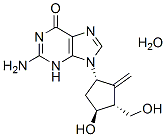| Cas No.: | 209216-23-9 |
| Chemical Name: | Entecavir hydrate |
| Synonyms: | BMS-200475; BMS 200475; BMS200475; BMS 200475-01; BMS-200475-01; Entecavir hydrate; Entecavir monohydrate; Baraclude. |
| SMILES: | O=C1NC(N)=NC2=C1N=CN2[C@@H]3C([C@H](CO)[C@@H](O)C3)=C.O |
| Formula: | C12H17N5O4 |
| M.Wt: | 295.29 |
| Purity: | >98% |
| Sotrage: | 2 years -20°C Powder, 2 weeks 4°C in DMSO, 6 months -80°C in DMSO |
| Description: | Entecavir monohydrate (SQ 34676; BMS 200475) is a potent and selective inhibitor of HBV, with an EC50 of 3.75 nM in HepG2 cell. |
| Target: | EC50:3.75 nM (anti-HBV, HepG2 cell)[1] |
| In Vivo: | Daily oral treatment with BMS-200475 at doses ranging from 0.02 to 0.5 mg/kg of body weight for 1 to 3 months effectively reduces the level of woodchuck hepatitis virus (WHV) viremia in chronically infected woodchucks[3]. |
| In Vitro: | BMS-200475 has a EC50 of 3.75 nM against HBV. It is incorporated into the protein primer of HBV and subsequently inhibits the priming step of the reverse transcriptase. The antiviral activity of BMS-200475 is significantly less against the other RNA and DNA viruses[1]. Entecavir is more readily phosphorylated to its active metabolites than other deoxyguanosine analogs (penciclovir, ganciclovir, lobucavir, and aciclovir) or lamivudine. The intracellular half-life of entecavir is 15 h[2]. |
| Cell Assay: | BMS 200475 is prepared in phosphate-buffered saline (PBS) and diluted with appropriate medium containing 2% fetal bovine serum. HepG2 2.2.15 cells are plated at a density of 5×105 cells per well on 12-well Biocoat collagen-coated plates and are maintained in a confluent state for 2 to 3 days before being overlaid with 1 mL of medium spiked with BMS 200475. Quantification of HBV was performed on day 10[1]. |
| References: | [1]. Innaimo SF, et al. Identification of?BMS-200475?as a potent and selective inhibitor of hepatitis B virus. Antimicrob Agents Chemother. 1997 Jul;41(7):1444-8. [2]. Rivkin A, et al. A review of entecavir in the treatment of chronic hepatitis B infection. Curr Med Res Opin.?2005 Nov;21(11):1845-56. [3]. Genovesi EV, et al. Efficacy of the carbocyclic 2'-deoxyguanosine nucleoside?BMS-200475?in the woodchuck model of hepatitis B virus infection. Antimicrob Agents Chemother.?1998 Dec;42(12):3209-17. |

 To enhance service speed and avoid tariff delays, we've opened a US warehouse. All US orders ship directly from our US facility.
To enhance service speed and avoid tariff delays, we've opened a US warehouse. All US orders ship directly from our US facility.




















